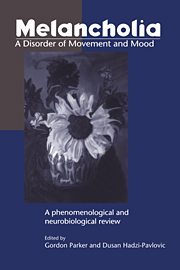Book contents
- Frontmatter
- Contents
- List of contributors
- Acknowledgments
- Introduction
- Part One Classification and Research: Historical and Theoretical Aspects
- 1 Issues in Classification: I. Some Historical Aspects
- 2 Issues in Classification: II. Classifying Melancholia
- 3 Issues in Classification: III. Utilising Behavioural Constructs in Melancholia Research
- 4 Issues in Classification: IV. Some Statistical Aspects
- Part Two Development and Validation of a Measure of Psychomotor Retardation as a Marker of Melancholia
- Part Three The Neurobiology of Melancholia
- The CORE Measure: Procedural Recommendations and Rating Guidelines
- References
- Author Index
- Subject Index
3 - Issues in Classification: III. Utilising Behavioural Constructs in Melancholia Research
from Part One - Classification and Research: Historical and Theoretical Aspects
Published online by Cambridge University Press: 04 August 2010
- Frontmatter
- Contents
- List of contributors
- Acknowledgments
- Introduction
- Part One Classification and Research: Historical and Theoretical Aspects
- 1 Issues in Classification: I. Some Historical Aspects
- 2 Issues in Classification: II. Classifying Melancholia
- 3 Issues in Classification: III. Utilising Behavioural Constructs in Melancholia Research
- 4 Issues in Classification: IV. Some Statistical Aspects
- Part Two Development and Validation of a Measure of Psychomotor Retardation as a Marker of Melancholia
- Part Three The Neurobiology of Melancholia
- The CORE Measure: Procedural Recommendations and Rating Guidelines
- References
- Author Index
- Subject Index
Summary
Introduction
Much of the work described in this book represents a specific attempt to identify a key behavioural construct, namely psychomotor change, which appears to underpin an important clinical entity, namely melancholia. Conceptually, this represents a different approach to much current clinical research which utilizes broad, non-specific diagnostic categories. The logical developments of this departure – identification of key constructs, and the systematic investigation of the patterns of association between these key constructs – are described. Such patterns of association are hypothesised to be sensitive indicators of underlying neurobiological processes and, hence, the basis of more focussed neurobiological research. Even if major discoveries occur outside the clinical realm (as is likely in the realms of molecular biology, genetics and neurochemistry), the examination of the relationships between such fundamental processes and refined behavioural constructs will be more useful than studying the relationships between such processes and broader clinical syndromes. The application of this approach to current neurobiological research in melancholia will now be detailed.
Clinical Heterogeneity Impedes Neurobiological Research
Attempts to link broad diagnostic groups in psychiatry with specific neurobiological processes are hampered currently by unacceptable heterogeneity among formally categorised patient samples. This heterogeneity is intrinsic to the current icd-10 (World Health Organization 1992) and dsm-iv (American Psychiatric Association 1994) international classification systems. In an attempt to satisfy clinical, administrative and epidemiological needs, these systems have adopted broad class notions and non-specific diagnostic algorithms.
- Type
- Chapter
- Information
- Melancholia: A Disorder of Movement and MoodA Phenomenological and Neurobiological Review, pp. 38 - 56Publisher: Cambridge University PressPrint publication year: 1996
- 6
- Cited by



